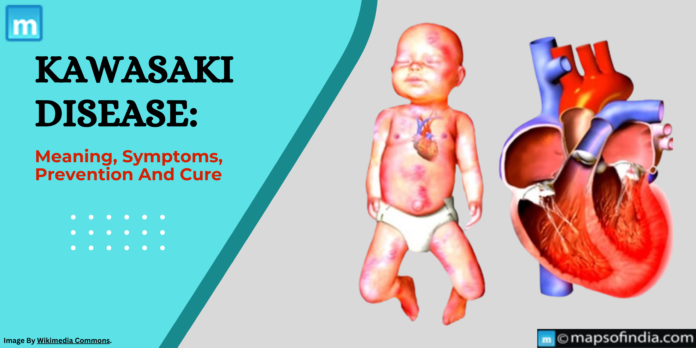Kawasaki disease, sometimes called Kawasaki syndrome, is a rare but severe condition that primarily affects children under the age of five. It causes swelling (inflammation) in blood vessels throughout the body and was discovered in Japan in the 1960s by Dr. Tomisaku Kawasaki. Researchers have made considerable progress in understanding this illness throughout the years. However, much more has to be discovered about its exact aetiology and how to prevent and treat it effectively. While the origin is unknown, early detection and treatment are critical to avoiding serious complications, mainly heart difficulties.
Symptoms
One of the difficulties in identifying Kawasaki Disease is the broad spectrum of symptoms, which can frequently mirror other juvenile disorders. However, some distinguishing features include prolonged fever (lasting more than five days), redness in the eyes (conjunctivitis), swollen lymph nodes in the neck, rash, redness and swelling of the hands and feet, and irritation and swelling of the mouth, lips, and throat. In severe cases, Kawasaki Disease can cause inflammation of blood vessels throughout the body, including the coronary arteries, resulting in serious problems such as coronary artery aneurysms and heart disease.
Prevention
As the exact cause of Kawasaki Disease remains unknown, prevention strategies primarily focus on early detection and prompt treatment to prevent complications. Parents and caregivers should watch for symptoms like extended fever and rash in children, especially if other Kawasaki Disease symptoms are present. Seeking medical help right away is critical for initiating therapy and lowering the chance of complications. While there are no established prevention strategies for Kawasaki Disease, practising good hygiene, such as handwashing, may help lower the chance of catching infections that could cause the disease.
Cure
Treatment for Kawasaki Disease usually consists of a combination of medicines to lower inflammation and prevent complications. Intravenous immunoglobulin (IVIG) is an integral part of the treatment, as it helps to reduce inflammation and protect the blood vessels. High-dose aspirin may also be used to lower fever and inflammation. In most cases, with quick and adequate treatment, children with Kawasaki Disease recover completely without long-term problems. However, if coronary artery complications develop, continued monitoring and management may be required to avoid developing heart-related issues.
Advancements in Research
Kawasaki Disease research continues to yield fresh insights into the disease’s basic processes and potential treatments. While there is still much to discover, continuing research is looking into various topics, including the role of genetics, immune system malfunction, and environmental variables in disease development. Improved understanding of these characteristics may lead to the development of more focused medicines, resulting in better outcomes for children with Kawasaki Disease.
Living with Kawasaki Disease
Most children with Kawasaki disease recover entirely with early detection and treatment. However, long-term follow-up with a cardiologist is required to watch for potential heart abnormalities that may arise later. Kawasaki disease, albeit uncommon, necessitates rapid medical attention because of the possibility of heart problems. Understanding the symptoms and obtaining appropriate medical guidance is critical for effective care and complete recovery for your child. Remember that this material is not a substitute for expert medical advice. Always seek diagnosis and treatment from a skilled he




